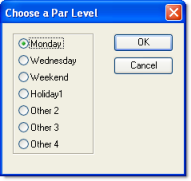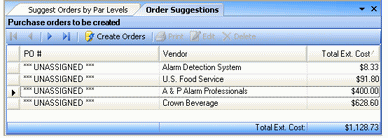Suggest Orders by Par Level
Compeat can suggest orders based on your current inventory levels and
defined stock and reorder par levels. There are two methods that you can
use to have Compeat suggest orders:
For a single
vendor Click the Suggest Orders
button on the Orders screen. After specifying the par level, an order
is suggested for the current vendor. This is described in further
detail below.
For multiple
vendors Select the Suggest Orders by Par Levels from the Transactions
menu. This feature will suggest ordering from the lowest priced vendor
on Bid
Items and suggest ordering from the Preferred
vendor on non-bid items. After making any desired changes, you can
create orders for the suggested items—
more than one order for more than one vendor will usually be created.
Each of these orders can be reviewed and modified using the Orders
screen. This is described in further detail below.
 Visit the Compeat
Support Website for additional information on this topic and more.
Visit the Compeat
Support Website for additional information on this topic and more.
Note: When creating a suggested order of either type, you
will be asked if you want to add unposted invoices to the current quantity
on-hand for each item. If counts have been posted but the AP invoices
have not, then you should select No;
otherwise select Yes.
About Par Levels
You can define up to seven par levels in Compeat. Name the par levels
in the Setup > Other Definitions > Other tab. Par level amounts
can then be defined:
For one
inventory item under Inventory
> Restaurant Inventory Items
> Restaurant Inventory Items > Par
Levels/Vendor Info.
For multiple
inventory items under Inventory > Restaurant Inventory Items
> Par Maintenance.
For all suggested orders, you must specify which par level Compeat should
use. The suggested order will include all of the items with defined par
values for the specified par level. However, only those items whose reorder
level is greater than the theoretical quantity on-hand will have a quantity included (a quantity that
will be the difference between the theoretical quantity on-hand and the
stock level). When a suggested order is saved, only the items with a quantity
will be included—
items with a zero quantity will omitted.
Example: Assume
you defined two inventory items, Chardonnay Wine and Bottled Beer with
the same reorder par level of
10 and the same stock par level
of 20. The theoretical quantity on-hand of the Chardonnay Wine is 15 and
the theoretical quantity on-hand of the Bottled Beer is 6. When you have
Compeat suggest an order, both items will be included in the order listing
because both have par levels defined; however, the quantity to order of
the Chardonnay Wine will be zero (the quantity on-hand, 15, is greater
than the reorder par level, 10), while the quantity to order of the Bottled
Beer will be 14 (stock par level, 20, minus the theoretical quantity on-hand,
6). Therefore, when the order is saved, it will only include Bottled Beer,
not Chardonnay Wine.
Note: The quantity that Compeat suggests to be ordered
uses the purchase unit for the specified vendor. The system first calculates
the quantity to order in inventory units (which is what the theoretical
quantity on-hand and par values are specified in), then converts to the
purchase unit for the preferred vendor. If you choose a different purchase
unit here, Compeat will automatically update what the preferred vendor/purchase
unit choice is. If the calculated purchase unit quantity is not an integer,
Compeat will round to the nearest integer (up to the next number if equal
or greater than 0.5, down if less than 0.5).
How Suggested Orders are Calculated
Compeat determines the quantities needed for each
item using the following calculation:
Stock
Par Level – (Theo
Qty On-Hand + # on Order, if < Reorder Par Level)
where the values are determined as follows:
-
Theo
Qty On-Hand This figure is viewable for each item on its
Restaurant Inventory Item screen. The number reflects the latest
running total from various postings in Compeat, including the
latest sales mix data, orders received, wasted or donated designations,
quantities past their shelf life, and posted counts. The posting
of a count updates the theoretical number with actual data, which
becomes theoretical again the next time there is a different posting.
The value of this calculation is displayed in
the Needed column only if the
Reorder Par Level was passed by inventory depletion. If inventory depletion
has not reached the reorder level, the Needed
column displays a zero.
Then the value of the Needed
column is converted from Inventory Units to Purchase Units, and the # to Order column is filled with
the number of purchase units necessary to equal or surpass the Needed
column value.
Creating an Order for Single Vendor
To
create a suggested order from the Order screen, open the Order screen
(Transactions > Orders) and select Add
Record to create a new order. Specify the order date and a
due date.
Specify
a vendor name, then click the Suggest
Order button; a dialog box similar to the following will display:

From
the dialog box, select the par level to use, and then click OK.
Compeat
will create a list of all of the inventory items for this vendor that
have par values defined for the specified par level.
Note: When determining the quantities
to specify on the suggested order Compeat will take into account quantities
on unposted invoices, unposted manual checks, and saved orders.
As with any other order, you can make any needed changes to quantities
or items, whether they are quantities of zero or not.
Modify the order detail as necessary;
you can add an item, delete an item, change a purchase unit, change
an amount, and so on.
Complete
your order by saving it; then print, transmit, or email the order.
Creating Orders for Multiple Vendors
Perform the following steps to create a suggested orders for multiple
vendors.
Select
Transactions > Suggest Orders by Par Level. Your latest orders
will be displayed.
Select
a par level from the drop-down menu, and then click Suggest
Orders.
All active inventory items will be displayed for
the current restaurant with par values defined for the specified par level,
and with a preferred vendor specified. Even if the suggested order quantity
is zero, these inventory items will display. When you create orders, all
zero-quantity items will be automatically removed from the order.
Filter
items (optional).
By default, the screen displays all of the inventory items for all
inventory items levels; you can display only certain categories (for
example, if you are only interested in Food/Produce) by clicking on
the filter icon  above
the column you want to filter by, and then selecting a filter criteria
from the drop-down list. See Filter
List.
above
the column you want to filter by, and then selecting a filter criteria
from the drop-down list. See Filter
List.
Modify the order detail as necessary;
you can add an item, or change a quantity, vendor (by default Compeat
suggests the preferred vendor), purchase unit, or amount each.
When
ready, click Show Order Summary
to view a summary of your orders. You will be shown a summary of your
order on the Order Suggestion screen, similar to the following:

After reviewing the order summaries, click Create Orders to create the orders.
Note: You can print a copy of the order by selecting Print from the toolbar to open the
Purchase Orders report. If you wish to email your orders, select each
order, click Edit, then email
the order from the standard order screen.
![]() Visit the Compeat
Support Website for additional information on this topic and more.
Visit the Compeat
Support Website for additional information on this topic and more.
